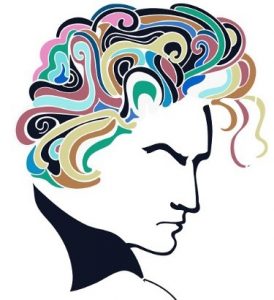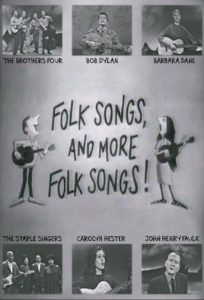by mr tambourine
I’m sometimes intrigued by how much Dylan fans actually don’t know or aren’t aware of about Bob, even though they have, and show, a desire to know a whole lot more than they already do.
By no means am I trying to suggest that I know more than anybody or that I figured out what it’s all about. In fact, I don’t even consider myself to be a great Dylan fan or a great researcher. I just see myself as a person who’s lucky enough and was at the right place at the right time to learn all the things that I have learned over the years.
However I haven’t stumbled upon a person like Bob whose life is so complex and so relevant, but yet so rarely talked about.
When you take a look at celebrities, whether the ones when Dylan was starting out, or the ones that have come and gone throughout his career and life, especially the big ones, you pretty much know what to expect of them.
Even the great literary figures, or the great scientists, or world leaders… All of those people are familiar to the public; you can see why they are who they are.
Dylan, on the other hand, is a complete mystery. So many things in his life and career are guesses or speculations. God knows how many misconceptions are there about him. No wonder he never wanted to talk about his personal life too much.
Yes, we’ve had books written about him, movies made about him, even Dylan himself gave us Chronicles volume 1 back in the day. But does that reveal anything much? Not really.
There’s so much more out there.
It’s a pattern that there’s always something not many people know about out there in existence. But I would like to start out with 1989 and try to give you some rare info you might not have caught, even if you did the research.
1989 is the beginning of Dylan’s complete disappearance from the public eye. Not that he was very easily spotted before that, but in the years 1961-1988 you can still find a handful of stories. 1989 is the beginning of major silence.
In the 1961-1988 period, you can find a lot of interviews, many have at least audio, while some even have footage. But from 1989, it became rare for Dylan to do any interviews.
I’m not gonna get into details why Dylan decided to hide so much, as I don’t have any proof. I wouldn’t mind guessing of course, but then I could keep guessing all day and it probably wouldn’t take us anywhere.
Instead I want to start with the Oh Mercy sessions in 1989.
Bob covers this period in his memoir Chronicles volume 1, and gives us a lot of alternate lyrics to the songs. But something he hasn’t covered in the book, that exists on Bjorner’s Still On The Road page, in the Oh Mercy sessions, is a song by the name of Three Of Us Be Free.
Any info about this song is hard to find, but luckily, I know where to look and have found some information regarding this song. I looked at one of my favorite sources for these things, and it’s a site Searching For A Gem, which has a special section called “Starlight In The East – Dylan’s unreleased songs”.
Here, you have thousands of songs, in alphabetical order. Not all of them are unreleased, as some of them eventually got released, since the site was apparently first edited many years ago, in the really early days of the internet.
As for the song “Three Of Us Be Free”, here is the info we have:
According to Michael Krogsgaard, the song was recorded in two takes at Studio On The Move, New Orleans, LA, 14-15 Mar 1989, during the “Oh Mercy” sessions. This was originally identified as an alternate title for BROKEN DAYS, later released on “Oh Mercy” as EVERYTHING IS BROKEN, but in his book “Still On The Road – The Songs Of Bob Dylan Vol. 2: 1974-2008” (Constable, 2010), Clinton Heylin thinks it’s is a different, still released, song
Make of it as you will.
All we know so far is that it’s the only song from the Oh Mercy sessions which we haven’t heard about.
Also, I think the only songs whose alternate versions we haven’t heard, whether officially released or in circulation are Man In The Long Black Coat and Where Teardrops Fall. According to Bjorner, there are multiple takes of Where Teardrops Fall, while Man In The Long Black Coat seems to have only two takes.
If we were heading to 1990, this was one of the last times ever that you could get informed about Dylan’s studio work, or even what he was up to behind the stage, whether we’re talking about rehearsals, soundchecks or his private life. This is when it all became more mysterious than ever.
Let’s first take a look at the Under The Red Sky sessions.
Seems like the first sessions took place on January 6 1990 in Oceanway Studios in Los Angeles.
During these sessions, Bjorner lists these songs as being performed:
- Handy Dandy
- Handy Dandy
- 10,000 Men
- God Knows
- Cat’s In The Well
Then Bjorner also lists more sessions and takes at Record Plant Studio, The Complex Studio, The Sorcerer Studio Los Angeles, California from Mid March to Early April 1990, produced by Don Was, David Was and Jack Frost.
- Wiggle Wiggle
- Under The Red Sky
- Unbelievable
- Born In Time
- Born In Time
- T.V. Talkin’ Song
- T.V. Talkin’ Song
- 2 x 2
- 2 x 2
- Shirley Temple Don’t Live Here Anymore
- Under The Red Sky
- Unbelievable
- Unbelievable
- Born In Time
- Born In Time
- T.V. Talkin’ Song
- T.V. Talkin’ Song
- 2 x 2
- 2 x 2
- Wiggle Wiggle
- Some Enchanted Evening (Rodgers-Hammerstein II)
Of the unknown songs that you see on this list, obviously, Shirley Temple Don’t Live Here Anymore stands out.
Once again, Searching For A Gem, through Starlight In The East, provides info about this song:
“Out-take from the Don Was-produced album “Under The Red Sky”, which may have been recorded at The Complex, Los Angeles, CA, 19-20 Apr 1990. This song was originally intended to be recorded by dance artist Paula Abdul! It was recorded in the early 1990s by Was (Not Was) as MR. ALICE DOESN’T LIVE HERE ANY MORE but not released. They performed it live on radio as part of a Dylan tribute called “Oh Merci”, broadcast on KCRW radio, Santa Monica, CA, on 04 Jul 1993. Thanks to Gil Walker for this quote from Don Was: “There’s one song that we wrote with Bob Dylan when I was producing “Under the Red Sky.” We were sitting around watching “I Dream of Jeannie” in the lounge, and I thought, ‘This was kind of a waste. You work all your life to be able to hang out with your hero and then you end up watching “I Dream of Jeannie.”‘ So at the time, my wife [then in A&R for Virgin Records] had signed Paula Abdul so she was about to record her second album. So I said, ‘Let’s write a song for Paula Abdul.’ So Bob shut the TV off and he, David and I wrote “MR. ALICE DOESN’T LIVE HERE ANY MORE.” Thanks to Harold Lepidus for news that the song is now included on the Was (Not Was) Rykodisc album “Boo!” (Rykodisc RCD-10943, USA, 2008) and thanks to Jack from Canada for the scan.”
As for Some Enchanted Evening, Searching For A Gem has an answer as well:
“Out-take from “Under The Red Sky”, recorded at The Complex, Los Angeles, CA, March 1990 – could it be the standard from “South Pacific” by Jerome Kern/Oscar Hammerstein, recorded by Bob for “Shadows In The Night”, 2015?”
Even though Bjorner lists it as definitely a song by Rodgers and Hammerstein, not Kern and Hammerstein, but okay.
Would also like to add that I’ve heard rumours that there are incredibly longer versions of Handy Dandy and Under The Red Sky, that go up to 30-60 minutes. Not sure how accurate that is.
I’ve looked at Searching For A Gem for some possible info, but I haven’t found any.
We’re still in 1990, past the Under The Red Sky sessions, and unto the rare July/August 1990 rehearsals before tour.
I found this on Bjorner, and he states these were rehearsed:
- Unidentified Studio
- Unidentified Location, U.S.A
- July-August 1990
- Rehearsals before tour.
- In The Pines (Huddie “Leadbelly” Leadbetter)
- Man Of Constant Sorrow (trad. arr. by Bob Dylan)
- A Long Time A-Growin’ (trad.)
- Hey La La (Hey La La) (McBride)
- Precious Memories (arr. by Bob Dylan)
- House Of Gold (Hank Williams)
- Peace In The Valley (Thomas A. Dorsey)
- Everybody’s Rockin’ (Neil Young)
- (Sittin’ On) The Dock Of The Bay (Steve Cropper – Otis Redding)
- Stand By Me (Charles Albert Tindley)
- Moon River (Henry Mancini – Johnny Mercer)
- Shut Your Mouth
- Trouble
- On A Night Like This
- Eternal Circle
- Spanish Harlem Incident
- Heart Of Mine
- Had A Dream About You, Baby
- One More Cup Of Coffee (Valley Below)
- When Did You Leave Heaven? (W. Bullock – R. Whiting)
What’s special about these songs? To find out let’s get into detail using Bob Dylan’s official website as a source.
In The Pines
This song was performed by Bob only five times live, and all the performances happened before this rehearsal. Dylan hasn’t done it since this rehearsal.
Man Of Constant Sorrow
This song was only performed nine times before this rehearsal, and it was performed 13 times since then, but only five times in 1990. It was then not played until 2002, when it was performed in a electric arrangement, that was very intense.
A Long Time A-Growin’
This song was only performed twice, in 1961, and not played live since this rehearsal in 1990.
Hey La La
Only performed three times in 1989 live and never again, not even after this 1990 rehearsal.
Precious Memories
Only performed 3 times, twice in 1989 and once in 1990 but before this rehearsal, on January 12 1990. Not performed since the rehearsal.
House Of Gold
Only performed twice live, both times in 1989 and not since.
Peace In The Valley
Performed only once in 1989 and never again.
Everybody’s Rockin’
Never performed live
The Dock Of The Bay
Performed once live, after this rehearsal
Stand By Me
Performed once live, after this rehearsal. Also read during the Musicares 2015 speech.
Moon River
Performed twice live, both times after this rehearsal, once in 1990 and once in 2018
Shut Your Mouth
I used Searching For A Gem for this, here: “Included in a list of songs rehearsed at Montana Studios, New York, July-August 1990, in the section marked “electric B.D.” and not in the section marked “electric covers”, but no other details are known.” This song was never played live.
Trouble
Performed seven times live, but in 1989 only.
On A Night Like This
Never played live
Eternal Circle
Played 3 times live in 1963 and 1964 only.
Spanish Harlem Incident
Performed only once live in 1964 and not again
Heart Of Mine
It was previously played only once in 1989, which was the first performance since 1987 of the song. Not played in 1990 at all. However, it was performed only once after 1989, and that was in 1992 and not since then.
Had A Dream About You Baby
Performed only four times in 1988 and not again
One More Cup Of Coffee
Not performed in 1990 after this rehearsal, even though it was played 3 times earlier in the year. Played live 7 more times in 1991, 1993, 2007 and 2009.
When Did You Leave Heaven?
Not played in 1990 after this rehearsal, but played twice in 1991 and never again.
The rare appearances for these songs overall in Bob’s career, makes this rehearsal precious to behold. Unfortunately, it’s not in circulation currently. Hopefully someday.
One of the Holy Grails for hardcore Dylan fans is to one day get a hold of the Bromberg Sessions of 1992.
Here’s some info using Wikipedia:
“Since launching the Never Ending Tour in June 1988, traditional covers became a feature at virtually every Dylan concert, often as part of an acoustic set. After recording Under the Red Sky in 1990, Dylan would not release an original song until 1997, and during that time, he would increasingly rely on his stockpile of covers for ‘fresh’ material. Dylan called these covers “the music that’s true for me”.”
Dylan scheduled studio time at Chicago’s Acme Studios in early June 1992, hiring long-time associate David Bromberg as his producer. An album’s worth of cover songs were recorded at these sessions with the accompaniment of a full band. The recording engineers were Blaise Barton and Dan White. For reasons unknown, Dylan scrapped the release of this album, deciding to record solo acoustic material instead. Two songs from the Bromberg sessions, “Duncan and Brady” and “Miss the Mississippi”, would eventually be released on the album The Bootleg Series Vol. 8: Tell Tale Signs: Rare and Unreleased 1989–2006. All of the songs for Good As I Been to You were recorded later at Dylan’s garage studio at his home in Malibu, sessions that are believed to have taken place from late July to early August 1992.
Basically, Dylan abandoned the Bromberg Sessions, to work later on Good As I Been To You.
Now, let’s take a look at the full list of songs from those sessions from Bjorner:
- Acme Recording
- Chicago, Illinois
- 3-5 June 1992
- Produced by David Bromberg.
- Rise Again (trad.)
- Nobody’s Fault But Mine (Blind Willie Johnson)
- The Lady Came From Baltimore (Tim Hardin)
- Polly Vaughan (trad.)
- Casey Jones (trad.)
- Duncan And Brady (trad.)
- Catskills Serenade (David Bromberg)
- World Of Fools (David Bromberg)
- Miss The Mississippi And You (Jimmie Rodgers)
- Sloppy Drunk (Jimmie Rodgers)
- Hey Joe (Billy Roberts)
- Northeast Texas Woman (Willis Alan Ramsey)
The reason why there’s hype for these sessions is because of not only the released Duncan And Brady and Miss The Mississippi, but also the circulating recordings of Polly Vaughan, Catskills Serenade and Sloppy Drunk are some of Dylan’s finest performances of the decade. Especially Polly Vaughan and Catskills Serenade have some of Dylan’s most emotional and finest vocals of the decade.
As far as Good As I Been To You goes, not much to say but that the album had an outtake, You Belong To Me.
Here’s some Wikipedia info:
When time came to sequence the album, producer Debbie Gold was unable to convince Dylan to include “You Belong to Me”. Though it wasn’t authentically traditional, it was popular enough to be covered by Jo Stafford, Patti Page and Dean Martin. The most popular version was recorded by the Duprees, one of the final Italian doo wop groups to make a wave in the early 1960s. Dylan’s version from the Good As I Been to You sessions eventually appeared in Oliver Stone’s controversial 1994 film Natural Born Killers and on its accompanying soundtrack album.
The series continues.




